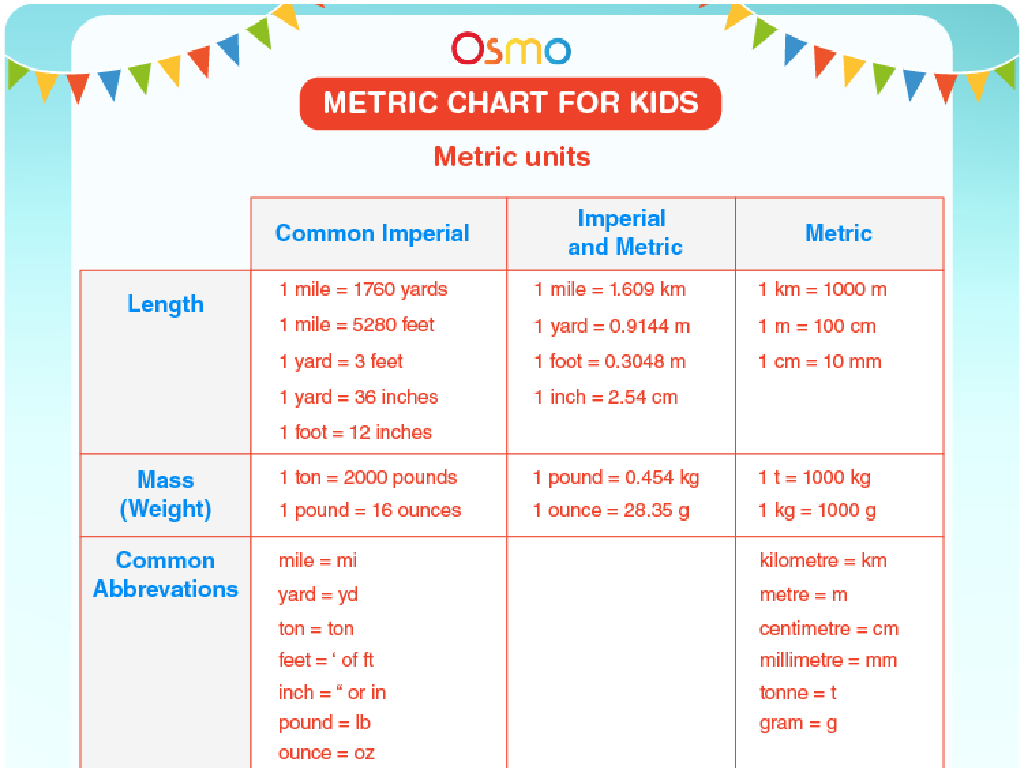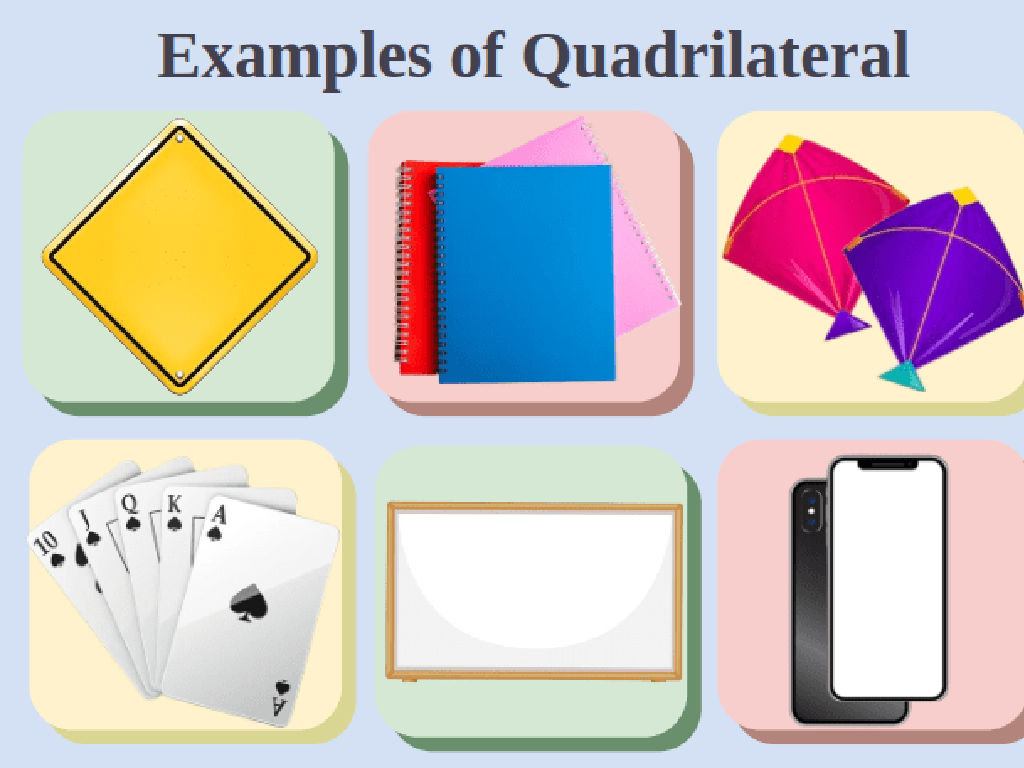Integer Multiplication And Division Rules
Subject: Math
Grade: Seventh grade
Topic: Operations With Integers
Please LOG IN to download the presentation. Access is available to registered users only.
View More Content
Integer Operations: Multiplication & Division
– What are integers?
– Integers include positive, negative numbers, and zero.
– Rules for multiplying integers
– Same signs multiply to positive, different signs to negative.
– Rules for dividing integers
– Same rules apply as multiplication for sign results.
– Applying rules in real life
– Calculate profits/losses, temperature changes using rules.
|
This slide introduces the concept of integers and focuses on the rules for multiplying and dividing them. Begin by ensuring students understand what integers are, including zero, positive, and negative numbers. Explain that when multiplying or dividing integers, the sign of the answer depends on the signs of the numbers involved: two integers with the same sign result in a positive product or quotient, while two integers with different signs result in a negative product or quotient. Provide real-life examples, such as calculating profits and losses in a business or temperature changes, to illustrate the application of these rules. Encourage students to think of other examples where integer operations are used in everyday life.
Understanding Integers in Math
– Integers: Definition
– Integers include whole numbers and their negatives, but not fractions or decimals.
– Positive vs. Negative Numbers
– Positive numbers are above zero, negative numbers are below zero.
– Integers in Daily Life
– Temperatures, bank balances, and elevations are common examples.
– Rules for Multiplication & Division
– Same signs multiply/divide to positive, different signs to negative.
|
Begin with a clear definition of integers, emphasizing that they consist of whole numbers, their opposites, and zero. Highlight the difference between positive and negative numbers using a number line as a visual aid. Provide relatable examples of integers from everyday life to help students see the relevance of the concept. Finally, introduce the rules for multiplying and dividing integers, ensuring to explain that the product or quotient of two integers with the same sign is positive, while the product or quotient of two integers with different signs is negative. Use examples to illustrate these rules, and prepare to offer additional practice problems in class.
Multiplying Integers: Rules and Examples
– Understand the Rule of Signs
– When multiplying, like signs give a positive, unlike signs give a negative.
– Multiply Positive by Positive
– Positive × Positive = Positive (e.g., 3 × 4 = 12)
– Multiply Negative by Negative
– Negative × Negative = Positive (e.g., -2 × -2 = 4)
– Multiply Positive by Negative
– Positive × Negative = Negative (e.g., 3 × -4 = -12)
|
This slide introduces students to the fundamental rules for multiplying integers, focusing on the Rule of Signs. It’s crucial for students to understand that the product of two integers with the same sign is always positive, while the product of two integers with different signs is always negative. Provide examples for each case to solidify understanding. Encourage students to practice with additional examples and to explain the reasoning behind the Rule of Signs to develop a deeper comprehension of integer multiplication.
Integer Multiplication Rules
– Multiplying two positives
– The product of two positive integers is positive (e.g., 3 x 4 = 12)
– Multiplying two negatives
– The product of two negative integers is positive (e.g., -2 x -3 = 6)
– Positive times a negative
– The product of a positive integer and a negative integer is negative (e.g., 5 x -2 = -10)
– Rules for multiplication
|
This slide aims to clarify the rules for multiplying integers. Start by explaining that multiplying two positive numbers yields a positive result, which aligns with their previous understanding of multiplication. Then, introduce the concept that multiplying two negatives results in a positive, which may be counterintuitive and will require examples and practice. Finally, discuss that a positive number multiplied by a negative gives a negative result. Emphasize that the sign of the product depends on the signs of the numbers being multiplied. Provide additional examples for each rule and encourage students to solve similar problems to reinforce their understanding.
Dividing Integers: Understanding the Rules
– Learn the Rule of Signs for Division
– When dividing, like signs give a positive, unlike signs give a negative
– Dividing Positives yields a Positive
– Positive ÷ Positive = Positive (e.g., 6 ÷ 2 = 3)
– Dividing Negatives yields a Positive
– Negative ÷ Negative = Positive (e.g., -6 ÷ -2 = 3)
– Dividing Positives with Negatives yields a Negative
– Positive ÷ Negative = Negative (e.g., 6 ÷ -2 = -3)
|
This slide introduces the fundamental rules for dividing integers, focusing on the Rule of Signs. It’s crucial for students to understand that the result of dividing two integers with the same sign is always positive, while dividing integers with different signs results in a negative number. Provide examples for each case to solidify understanding. Encourage students to practice with additional problems and to remember these rules as they work through them. Emphasize that understanding the concept of division as repeated subtraction can help in grasping why the Rule of Signs works as it does.
Integer Division Rules
– Dividing two positive integers
– The quotient of two positives is positive, e.g., 8 ÷ 2 = 4
– Dividing two negative integers
– The quotient of two negatives is positive, e.g., -8 ÷ -2 = 4
– Positive divided by negative
– A positive divided by a negative gives a negative, e.g., 8 ÷ -2 = -4
– Rules for integer division
– Remember: Same signs give a positive, different signs give a negative
|
This slide aims to clarify the rules for dividing integers. Start by explaining that the division is essentially repeated subtraction. When dividing two positive integers, the result is positive, just like normal division. For two negative integers, the negatives cancel out, resulting in a positive quotient. However, when a positive integer is divided by a negative integer, the result is negative, reflecting the idea of ‘owing’ in real-life contexts. Emphasize the general rule that division with the same signs results in a positive quotient, while division with different signs results in a negative quotient. Provide additional examples and encourage students to practice with various integer combinations to solidify their understanding.
Class Activity: Integer Operations Relay
– Split into teams for a math relay
– Solve integer multiplication/division
– Each member tackles one problem
– Pass to the next after solving
– First team with all correct wins!
– Accuracy matters as much as speed
|
This activity is designed to encourage teamwork and reinforce the rules of integer multiplication and division. Divide the class into small groups, ensuring a mix of abilities in each team. Provide each team with a set of problems that they must solve collaboratively, with each member solving one problem before passing the baton. The first team to finish with all correct answers wins a small prize. This will help students to engage with the material actively and support each other’s learning. Make sure to review the rules before starting: multiplying or dividing two positives or two negatives gives a positive result, while mixing signs gives a negative result. Circulate during the activity to offer guidance and ensure fair play.
Wrapping Up: Integer Operations
– Recap: Rules of Integer Operations
– Remember: Same signs multiply/divide to positive, different signs to negative
– Practice is key to mastery
– Regular practice solidifies understanding and improves skills
– Homework: Integer worksheet
– Complete the provided worksheet to practice multiplication and division of integers
– Be prepared to review answers
– We’ll go over the worksheet in the next class, so try your best!
|
This slide aims to summarize the lesson on integer multiplication and division rules. Emphasize the importance of remembering the sign rules, as this is a common area of confusion. Encourage students to practice regularly, as this will help them internalize the concepts. Assign the worksheet as homework to provide them with the opportunity to apply what they’ve learned. Make sure to let them know that the answers will be reviewed in the next class to address any questions or difficulties they may have encountered.





